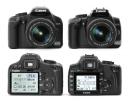Canon 450D Digital SLR Camera Review
 My first DSLR purchase was a Canon 400D, which I purchased in July 2007, so about 14 months ago. A great camera and the only reason I bought it was to use it for astronomy. But once I heard about the new 450D being released, I thought why not upgrade? Well I left it a while then after hearing a talk be Nik Symanchek I decided to go for it.
My first DSLR purchase was a Canon 400D, which I purchased in July 2007, so about 14 months ago. A great camera and the only reason I bought it was to use it for astronomy. But once I heard about the new 450D being released, I thought why not upgrade? Well I left it a while then after hearing a talk be Nik Symanchek I decided to go for it.
I ended up selling my 400D camera on Amazon and then purchased my new Canon 450D from Dixons, for £446 which luckily included a £50 cashback offer from Canon as well as free delivery at the time.
The main reason for the upgrade was the Live View mode, my main problem with doing astrophotography for me was getting the object in focus in the small cameras viewfinder. I did invest in a right angled viewfinder with 2x magnification, but even that was not that easy to use, but it did help.
 There is not a great deal of difference cosmetically between the cameras. The menus and layout of the camera are very similar. If you already have a 350d or 400d then you will find using the 450d really easy.
There is not a great deal of difference cosmetically between the cameras. The menus and layout of the camera are very similar. If you already have a 350d or 400d then you will find using the 450d really easy.
The new 450D is lighter than the 400D, it also has a nice feel to the grip now, with a kind of mottled effect. The 450D now comes with a Image Stabilised lens (IS) which is a nice touch.
On the back of the 450D are the biggest changes, with the buttons moved around in order to accommodate the new slightly larger 3 inch screen.
The Canon battery type has changed and the Compact Flash card slot has been replaced with an SD card, which is useful, as it seems most cameras have now gone back to SD cards, as my HD camcorder also takes SD cards.
The 450D now has 12 mega-pixels instead of the 10 mega-pixels in the 400D.
The Live View mode works in all modes except in Automatic mode, so don’t expect to use the live view just like a compact digital camera. After pressing the “Set” button to enter Live View mode you can zoom in on the object by 5x or 10x magnification, which should help with focusing whilst doing astrophotography. I think you can also get a live view through a PC or laptop, even more useful.
The standard ISO settings are still there. I would have thought we would have seen an ISO setting of 3200 available, but maybe that will be on the next model, 500D? I also think the next model will have 15 megapixels and probably an HD video recording facility. But we will have to wait and see.
Overall the 450D seems worth upgrading to if you really think you need an extra 2 megapixels or the live view mode, otherwise stick with the 400D if you have it. If you don’t have a DSLR then the Canon 450D is a great camera and worth a purchase.
The best price for the Canon 450D Digital SLR Camera seemed to be from either Dixons or Amazon when I was looking.

Thanks for info on the new Canon Do you think DSLR cameras are worth the price? Is the quality really that much greater than point and shoot? Just trying to decide whether to buy a DSLR or point and shoot. Thanks for any advice. Thanks
A DSLR is a must if you are doing some astrophotography, that is compared to a compact camera.
You could always go a specific CDD camera or web cam instead to begin with. I have a small compact Canon IXUS and the Canon 450D, both get used frequently for different situations.
Remember, more pixels without increasing the sensor size increases noise which is the last thing you want in a camera used for astrophotography. The 10 Mega-pixel 40D which also has live view is actually the better choice because of this. The ISO setting in a digital camera is not the same as the ISO of film. Most digital cameras “record” the photons that hit the sensor at 100 ISO. To get higher ISO the firmware simply amplifies the signal (multiplies the values it recorded on the sensor). That is why taking a photo at 100 ISO and post processing it on a computer can turn it into the exact same photo you can get if you took the image at 400 ISO originally. The problem is that amplification of the signal also amplifies any noise. A crude comparison between noise levels of a camera then is the highest ISO setting the camera supports to begin with. The 40D has ISO 3200 whereas the 450D 1600. Technical comparisons between the two have verified the 40D has lower noise than the 450D which makes sense since the 450D has more pixels in the same sensor size.